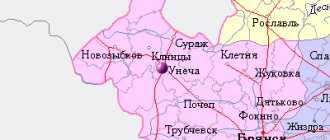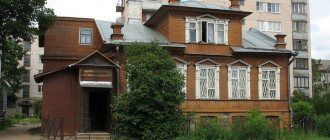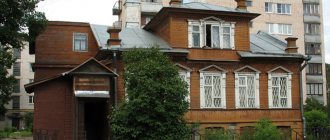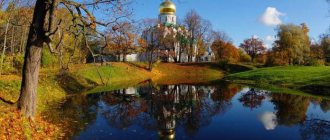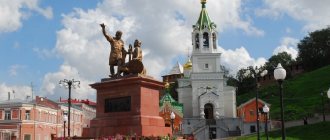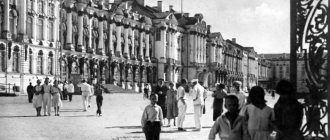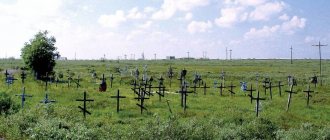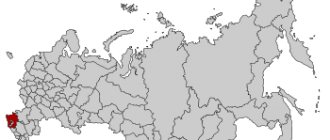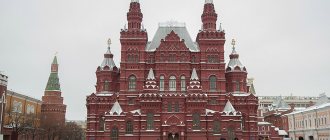Meadows
(Leningrad region)
OKATO code:
41233501
Founded:
1777
City since:
1777 City of district subordination (Luga district, Leningrad region)
Center:
Luga district
Telephone code (reference phone)
| 81372***** | 22-2-22 |
Deviation from Moscow time, hours:
0
Geographic latitude:
58°44′
Geographic longitude:
29°51′
Altitude above sea level, meters:
48 Sunrise and sunset times in the city of Luga
Luga: why it is called Northern Crimea and what 18-year-old Pushkin wrote about the city
We are going to Luga, a small town in the Leningrad region. Luga district is also called Northern Crimea
- it is the southernmost in the Leningrad region, and it rains less often there than, for example, in St. Petersburg. But life there doesn’t even remotely resemble a resort.
The meadow looks like a big chessboard. Only here it alternates not black and white, but wood and stone. On the main street, pre-revolutionary barracks are adjacent to equally old manor houses.
Architecture, cars are like greetings from the distant past, and even colorful advertising does not bring us back to the 21st century. Taxi driver Sergei Suprun spent almost half his life in such a barracks. A migrant from Chernobyl.
Sergei does not share our opinion that Luga is frozen in time.
Sergey Suprun, taxi driver:
“There’s a little bit of construction going on, a little bit of houses being built, at the end of the city.”
This is Sergei about the cottages that the city is growing in, and about one new multi-storey building for young families. We drive two minutes from the center - and now we’re on the outskirts, in the forest.
Sergey Suprun, taxi driver:
"Here you are! For mushrooms, for berries - everything grows!”
Please show us the sights. Takes you to the memorial cemetery. During the Great Patriotic War, the Luga defensive line passed here.
Luga is a city of military glory.
She held back the Nazi advance on Leningrad for three weeks and was under occupation for three years. Right there, outside the city, there is an industrial zone. There are two unique enterprises operating in Luga. The first, an abrasive plant, supplies half the country with tools. The second is even more specific.
The products of this plant are familiar to everyone who cannot imagine life without a sandwich or hot dog. And the company’s employees know without a calendar when holidays are in the country.
This is one of the largest enterprises in Luga. 500 people work here. Sausage casing plant. The one that is sometimes more natural than what is hidden underneath. They make it based on protein.
Now there is a rush at the plant - orders are coming in for the New Year. No matter how the ruble changes its exchange rate, people in the country will not stop eating sausage. However, they are not afraid of austerity here - for example, 90% of sausage casings are exported.
Sergei worked at a bakery. I received disability and was laid off. I haven't bought sausage for a long time. He has his own production at home.
Sergey, resident of Luga
: “Now when I come home, I’ll unravel it, these are the threads. Knit your socks or knit your own mittens.”
Sergei believes that Luzhans have two problems today. Lack of money and dirt in the city.
“There is a city in Russia called Luga, St. Petersburg district; This little town wouldn’t be any worse if it weren’t for my Novorzhev in the world.” This is how 18-year-old poet Alexander Pushkin
.
And this, by the way, is a branch of the Leningrad University named after him. Until 2011, the university bore the names of Cyril and Methodius. Lawyers, economists, biotechnologists and landscape architects are trained here. Neither students nor teachers are offended by the poet.
“The fact that here at the beginning of the century there were more taverns than public buildings for other purposes can also be found out in poetry, this is also no secret,” local residents say.
Luga did not become a city of highbrow intellectuals. A city of students - yes.
At the University of the Third Age - an hour of art therapy. The students, all over 50, draw their moods with their fingers.
“I really want to go to the sea, so I depicted here, or rather, I tried to depict Egypt,” says one of the university students.
So far, students have visited the UK, Germany and France. Getting ready for a trip to Spain. Before retirement we didn’t even dream about it. They decided to explore the world thoroughly - they study English here. In total, the university has 12 faculties. The most popular is information technology.
Natalya Stepanyuk, third-age university student:
“The most important thing now is to master a computer. No one had computers, no laptops, now each of us has a computer, a laptop, the Internet.”
Only the local House of Culture can compete for the right to be called the most interesting place in Luga with a university of the third age.
Judging by the posters, Luzhan residents never get bored - every day there is an exhibition or a concert. And in the summer, a brass band plays here, on Peace Square.
But young people are not interested in Komsomol meetings and coat fairs. Mikhail Zhikhorev left Luga at the age of 17. Now he is a resident of Yaroslavl, works as a network consultant, travels around the country and gives lectures to those who want to open their own business.
Mikhail Zhikhorev, network consultant:
“Well, yes, the city of Luga. On average, if you walk around the city, then yes, young people here don’t strive for anything. People who go to work, everything is so gray and ordinary.”
He will return to the ordinary and drab, as Mikhail puts it, Luga when his family completes the family nest.
In the meantime, he, like thousands of his peers, is ready to be only a guest in his hometown. Over the past 10 years, the population in Luga has been steadily declining. The name of the city, according to linguists, is associated with the Finno-Ugric people Vod. Its representatives lived in that area. And the word itself, translated from the language, meant “a place associated with salmon spawning.” This fish, by the way, is still depicted today on the official coat of arms of Luga.
Map
| Meadows: maps |
Meadows: photo from space (Google Maps) Meadows: photo from space (Microsoft Virtual Earth)
| Meadows. Nearest cities. Distances in km. on the map (in brackets along roads) + direction. Using the hyperlink in the distance , you can get the route (information courtesy of the AutoTransInfo website) | |||
| 1 | Batetsky (Novgorod region) | 28 (33) | IN |
| 2 | Plyussa (Pskov region) | 44 (105) | SW |
| 3 | Friendly Gorka | 62 () | WITH |
| 4 | Strugi Krasnye (Pskov region) | 67 (80) | SW |
| 5 | Siversky | 69 (78) | WITH |
| 6 | Soltsy | 73 (147) | YU |
| 7 | Shimsk (Novgorod region) | 77 (144) | SE |
| 8 | Vyritsa | 80 (94) | WITH |
| 9 | Pankovka (Novgorod region) | 82 () | IN |
| 10 | Volosovo | 82 (105) | WITH |
| 11 | Velikiy Novgorod | 86 (97) | IN |
| 12 | New World | 93 () | WITH |
| 13 | Gatchina | 94 (98) | WITH |
| 14 | Kingisepp | 100 (145) | NW |
| 15 | Bottom | 100 (158) | YU |
| 16 | Fornosovo | 101 () | NE |
| 17 | Volot (Novgorod region) | 102 (183) | SE |
| 18 | Kommunard | 103 (139) | WITH |
| 19 | Thais | 104 () | WITH |
| 20 | Lyuban | 105 (165) | NE |
| 21 | Russian-Vysotskoye | 107 () | WITH |
| 22 | Villosi | 108 () | WITH |
| 23 | Porkhov | 108 (132) | YU |
| 24 | Tosno | 108 (135) | NE |
| 25 | Slates | 109 (146) | NW |
| 26 | Proletary (Novgorod region) | 112 () | IN |
| 27 | Miracle | 112 (167) | IN |
| 28 | Ulyanovka | 113 (138) | NE |
| 29 | Krasny Bor | 115 () | NE |
| 30 | Ivangorod | 116 (170) | NW |
a brief description of
The city of Luga is located on the river. Luga, 139 km south of St. Petersburg.
Railway station on the line St. Petersburg - Pskov.
Territory (sq. km): 14
Information about the city of Luga on the Russian Wikipedia site
Historical sketch
Mentioned in the 15th century. in scribe books as the village of Luskoye in the Shelonskaya Pyatina (region) of the Novgorod land.
In 1777, with the establishment of the Pskov governorship, by order of Catherine II: “To establish a new city on the Luga River... naming this city Luga,” construction of a city began at the confluence of the river. Vrevka in the river Meadows. At the same time, the first stone buildings were laid: a church, a post office and a treasury.
The city is named after the river, and the name of the river is related to the Estonian laugas "swamp".
Since 1781, a district town in the St. Petersburg province.
In 1856, in the district town of Luga, St. Petersburg province, there were 2 churches, 167 houses, 28 shops.
At the end of the 19th century. There were 2 factories, a sawmill, a zemstvo hospital, and a theater in the city.
A.S. visited Luga several times. Pushkin, stopping on the way from St. Petersburg to the village of Mikhailovskoye. Poet S.Ya. Nadson, who visited the city in 1875, describes his impressions this way: “Luga is a small county town; If you count the stone buildings there, there are hardly five. The sidewalk is not paved and therefore there is terrible mud in the spring... One pharmacy, two hotels and a tavern - these are the buildings that catch the eye.”
During the Great Patriotic War of 1941-45, Luga was the site of fierce battles on the outskirts of Leningrad. It was occupied by Nazi troops on August 24, 1941. Liberated on February 12, 1944 by troops of the Leningrad Front during the Novgorod-Luga operation.
Economy
Abrasive, foundry and mechanical plants, microbiological and knitting industry enterprises. Mining and processing plant for molding materials.
Meadows is the center of the agricultural region (meat and dairy farming, vegetable growing).
Main enterprises
MECHANICAL ENGINEERING AND METAL WORKING
JSC "Luga Abrasive Plant"
188262, Leningrad region, Luga district, Luga, st.
Krasnoarmeyskaya, 32 Offers:
Grinding wheels, fireproof products: crucibles, muffles, graphite-containing products, “Effect” sponges
FOOD INDUSTRY
SE "Belkozin"
188260, Leningrad region, Luga district, Luga, Kievskoe highway, 137th km
Offers:
Sausage and sausage casings
Universities of the city
Peasant State University named after.
Cyril and Methodius 188230, Leningrad region, Luga district, Luga, Kirova Ave., 69
St. Petersburg Institute of Foreign Economic Relations, Economics and Law (Luga Branch)
188230, Leningrad region, Luga district, Luga, Volodarsky Ave., 44
Museums, galleries, exhibition halls
Luga Museum of Local Lore 188260, Leningrad region, Luga district, Luga, st. Red Artillery, 11-a Phone(s): (81372) 236-41
Architecture, sights
In the vicinity of Luga there is the former Domkino estate, which belonged to the Russian astronomer S.P. Glazenap. Artists I.N. lived in the former Kalganovka estate. Kramskoy, I.I. Shishkin, K.A. Savitsky. In the village of Spitsyno, on the shore of Lake Nalay, N.A. lived and worked. Rimsky-Korsakov.
| Population by year (thousands of inhabitants) | |||||||
| 1856 | 1.4 | 1970 | 31.9 | 2005 | 39.8 | 2015 | 36.5 |
| 1897 | 5.6 | 1979 | 37.7 | 2006 | 39.4 | 2016 | 36.1 |
| 1913 | 10.8 | 1989 | 41.8 | 2007 | 39.1 | 2017 | 35.8 |
| 1923 | 12.9 | 1992 | 41.8 | 2008 | 38.9 | 2018 | 35.3 |
| 1926 | 14.7 | 1996 | 41.5 | 2010 | 38.1 | 2019 | 35.0 |
| 1931 | 14.2 | 1998 | 41.0 | 2011 | 38.6 | 2020 | 34.6 |
| 1939 | 28.0 | 2000 | 40.5 | 2012 | 37.8 | 2021 | 33.7 |
| 1959 | 25.5 | 2001 | 40.2 | 2013 | 37.3 | ||
| 1967 | 29 | 2003 | 40.4 | 2014 | 36.8 | ||
MEADOWS
LUGA, a city in Russia, in the southwestern part of the Leningrad region, the center of the Luga district. Population 34.6 thousand people. (2019). Located on the river. Meadows. Junction railway station. The federal highway St. Petersburg - Pskov - Pustoshka - Nevel - the border with Belarus passes through Luga.
Story
On the site of modern Luga there was the village of Luskoye (Lusskoye), first mentioned in the scribe books of the Shelonskaya Pyatina of 1581–82. By decree of the imp. Catherine II 3(14).8.1777 on the so-called. On the Porkhov road (now the highway St. Petersburg - the border with Belarus) the city of Luga was established. District city of the Pskov governorship (1777–81), St. Petersburg province (1781–1927; in 1914–24 – Petrograd province, in 1924–27 – Leningrad province). In 1857, railway traffic was opened. line Gatchina - Luga, in 1859 - Luga - Pskov, in 1916 - Novgorod - Luga. During the Civil War of 1917–22, it was seriously damaged in 1919 during fierce battles between units of the Workers 'and Peasants' Red Army and units of the Northwestern Army under the command of Infantry General N. N. Yudenich. District (since 1927) and district (1927–30) center of the Leningrad region. During the Great Patriotic War, as a result of stubborn battles in the Luga area, the plans of the German command to capture Leningrad on the move through Luga and the Kaporsky plateau were thwarted. On August 24, 1941, it was occupied by German troops and severely destroyed. Liberated on February 12, 1944 during the Novgorod-Luga offensive operation. In 1939–2006, a city of regional subordination of the Leningrad region. City of Military Glory (2008).
Architecture. Cultural centers
The city developed according to a regular development plan approved by the emperor. Catherine II in 1778. Preserved: the Cathedral of the Great Martyr. Catherine (1780–86, rebuilt ca. 1848), c. Resurrection of Christ (1873–1887, architects V.V. Windelbandt, G.I. Karpov), Kazan Cathedral in neo-Byzantine style (1901–04, project by architect N.G. Kudryavtsev; icon of the Dormition of the Blessed Virgin Mary “Pecherskaya”, 18th century .), Pokrovskaya c. (1902–04, architect F. M. Verzhbitsky; rebuilt), ruins of a church. St. Nicholas at the Vrevskoye Cemetery (1908–10, architect V.N. Bobrov), adm. building con. 18th century Peasant State University named after. Cyril and Methodius (1991). Museum of History and Local Lore (1976).
Farm
There are factories in the city: abrasive (a large Russian manufacturer of abrasive tools, also producing refractory products for melting and casting metals), Luga Enterprise “Breeze” (electrical products and water filters), “Foresia Interior Luga” (production of plastic components for cars), “Khimik” (autochemicals, solvents, household chemicals, etc.), compound feed, “Belkozin” (high-quality protein casings for sausages), canning (canned meat and vegetables, jams); bakery, meat and dairy plants.
Neighborhood
In the vicinity of Luga there are preserved: trees. c. St. George the Victorious (1706–1709, rebuilt in 1896) in the village. Osmino, wood. c. Nativity of John the Baptist (until 1745) in the village. Shupogolovo, c. Tikhvin Icon of the Mother of God (1772–1776) in the village. Romanschina, ramparts of the fortification of the 10th–13th centuries, wooden. Uspenskaya c. (1844, architect M.P. Saker, built on the site of the Gorodetsky Monastery, 15th–18th centuries) in the village. Gorodets. Near the village Gostkino - Ioanno-Bogoslovsky Cheremenets male monastery. (founded in the late 15th century, closed in 1930, revived in 1997; ruins of the Cathedral of St. John the Evangelist, 16th century).
